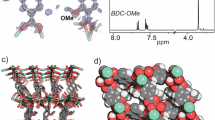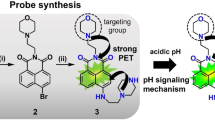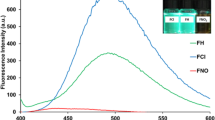Abstract
Since anions play a significant role in various biological phenomena, developing fluorescence anion sensors is important. Previously, we focused on polyhedral oligomeric silsesquioxane (POSS) as a three-dimensional (3D) scaffold to design an anion receptor. In this study, we evaluated the anion binding properties of an POSS derivative with eight urea groups and applied the derivative to an anion fluorescence sensor utilizing its 3D structure. 1H NMR measurements revealed that the POSS derivative with urea groups can bind to sulfate ions. Compared to the model compound, the POSS derivative exhibits a greater binding ability due to the cooperative effects of multiple urea groups. Through the introduction of naphthyl urea groups, the POSS derivative can be used as a fluorescence sensor for quantifying sulfate ions.
This is a preview of subscription content, access via your institution
Access options
Subscribe to this journal
Receive 12 print issues and online access
$259.00 per year
only $21.58 per issue
Buy this article
- Purchase on Springer Link
- Instant access to full article PDF
Prices may be subject to local taxes which are calculated during checkout







Similar content being viewed by others
References
Gonçalves MST. Fluorescent labeling of biomolecules with organic probes. Chem Rev. 2009;109:190–212.
Thomas SW, Joly GD, Swager TM. Chemical sensors based on amplifying fluorescent conjugated polymers. Chem Rev. 2007;107:1339–86.
He L, Dong B, Liu Y, Lin W. Fluorescent chemosensors manipulated by dual/triple interplaying sensing mechanisms. Chem Soc Rev. 2016;45:6449–61.
Gale PA, Caltagirone C. Anion sensing by small molecules and molecular ensembles. Chem Soc Rev. 2015;44:4212–27.
Barth MC, Church AT. Regional and global distributions and lifetimes of sulfate aerosols from Mexico City and southeast China. J Geophys Res. 1999;104:30231–9.
Rohde LH, Julian JA, Babaknia A, Carson DD. Cell surface expression of HIP, a novel heparin/heparan sulfate-binding protein, of human uterine epithelial cells and cell lines. J Biol Chem. 1996;271:11824–30.
Young RW. The role of the Golgi complex in sulfate metabolism. J Cell Biol. 1973;57:175–89.
Saini R, Kumar S. A fluorescent probe for the selective detection of sulfate ions in water. RSC Adv. 2013;3:21856–62.
Bondy CR, Gale PA, Loeb SJ. Metal−organic anion receptors: arranging urea hydrogen-bond donors to encapsulate sulfate ions. J Am Chem Soc. 2004;126:5030–1.
Emami Khansari M, Mirchi A, Pramanik A, Johnson CR, Leszczynski J, Hossain MA. Remarkable hexafunctional anion receptor with operational urea-based inner cleft and thiourea-based outer cleft: Novel design with high-efficiency for sulfate binding. Sci Rep. 2017;7:6032.
Tanaka K, Chujo Y. Chemicals-inspired biomaterials: developing biomaterials inspired by material science based on POSS. Bull Chem Soc Jpn. 2013;86:1231–9.
Tanaka K, Chujo Y. Advanced functional materials based on polyhedral oligomeric silsesquioxane (POSS). J Mater Chem. 2012;22:1733–46.
Chujo Y, Tanaka K. New polymeric materials based on element-blocks. Bull Chem Soc Jpn. 2015;88:633–43.
Gon M, Tanaka K, Chujo Y. Recent progress in the development of advanced element-block materials. Polym J. 2018;50:109–26.
Gon M, Tanaka K, Chujo Y. Recent progress on designable hybrids with stimuli-responsive optical properties originating from molecular assembly concerning polyhedral oligomeric silsesquioxane. Chem Asian J. 2022;17:e202200144.
Cordes DB, Lickiss PD, Rataboul F. Recent developments in the chemistry of cubic polyhedral oligosilsesquioxanes. Chem Rev. 2010;110:2081–173.
Du Y, Liu H. Cage-like silsesquioxanes-based hybrid materials. Dalton Trans. 2020;49:5396–405.
Kaneko Y. Ionic liquids containing silsesquioxane and cyclic siloxane frameworks. Chem Rec. 2023;23:e202200291.
Nagao M, Imoto H, Naka K. Tripod-shaped POSS compounds as single-component silsesquioxane hybrids. Polym J. 2024;56:31–42.
Kajiya R, Wada H, Kuroda K, Shimojima A. Inorganic–organic hybrid photomechanical crystals of azobenzene-modified polyhedral oligomeric silsesquioxane (POSS). Chem Lett. 2020;49:327–9.
Sakai H, Yung TM, Mure T, Kurono N, Fujii S, Nakamura Y, et al. Controlling circularly polarized luminescence using helically structured chiral silica as a nanosized fused quartz cell. JACS Au. 2023;3:2698–702.
Liu Y, Koizumi K, Takeda N, Unno M, Ouali A. Synthesis of octachloro- and octaazido-functionalized T8-cages and application to recyclable palladium catalyst. Inorg Chem. 2022;61:1495–503.
Lo MY, Zhen C, Lauters M, Jabbour GE, Sellinger A. Organic−inorganic hybrids based on pyrene functionalized octavinylsilsesquioxane cores for application in OLEDs. J Am Chem Soc. 2007;129:5808–9.
Furgal JC, Jung JH, Goodson TII, Laine RM. Analyzing structure–photophysical property relationships for isolated T8, T10, and T12 stilbenevinylsilsesquioxanes. J Am Chem Soc. 2013;135:12259–69.
Gon M, Sato K, Tanaka K, Chujo Y. Controllable intramolecular interaction of 3D arranged π-conjugated luminophores based on a POSS scaffold, leading to highly thermally-stable and emissive materials. RSC Adv. 2016;6:78652–60.
Gon M, Sato K, Kato K, Tanaka K, Chujo Y. Preparation of bright-emissive hybrid materials based on light-harvesting POSS having radially integrated luminophores and commercial π-conjugated polymers. Mater Chem Front. 2019;3:314–20.
Gon M, Saotome S, Tanaka K, Chujo Y. Paintable hybrids with thermally stable dual emission composed of tetraphenylethene-integrated POSS and MEH-PPV for heat-resistant white-light luminophores. ACS Appl Mater Interfaces. 2021;13:12483–90.
Iizuka D, Gon M, Tanaka K, Chujo Y. Acceleration of chemiluminescence reactions with coumarin-modified polyhedral oligomeric silsesquioxane. Bull Chem Soc Jpn. 2022;95:743–7.
Naka K, Fujita M, Tanaka K, Chujo Y. Water-soluble anionic POSS-core dendrimer: synthesis and copper(II) complexes in aqueous solution. Langmuir. 2007;23:9057–63.
Tanaka K, Inafuku K, Naka K, Chujo Y. Enhancement of entrapping ability of dendrimers by a cubic silsesquioxane core. Org Biomol Chem. 2008;6:3899–901.
Tanaka K, Inafuku K, Chujo Y. Environment-responsive upconversion based on dendrimer-supported efficient triplet–triplet annihilation in aqueous media. Chem Commun. 2010;46:4378–80.
Tanaka K, Jeon JH, Inafuku K, Chujo Y. Enhancement of optical properties of dyes for bioprobes by freezing effect of molecular motion using POSS-core dendrimers. Bioorg Med Chem. 2012;20:915–9.
Tanaka K, Okada H, Ohashi W, Jeon JH, Inafuku K, Chujo Y. Hypoxic condition-selective upconversion via triplet–triplet annihilation based on POSS-core dendrimer complexes. Bioorg Med Chem 2013;21:2678–81.
Kaneshiro TL, Wang X, Lu ZR. Synthesis, characterization, and gene delivery of poly-l-lysine octa(3-aminopropyl)silsesquioxane dendrimers: nanoglobular drug carriers with precisely defined molecular architectures. Mol Pharmaceutics. 2007;4:759–68.
Cai X, Jin R, Wang J, Yue D, Jiang Q, Wu Y, et al. Bioreducible fluorinated peptide dendrimers capable of circumventing various physiological barriers for highly efficient and safe gene delivery. ACS Appl Mater Interfaces. 2016;8:5821–32.
Xiang K, Li Y, Xu C, Li S. POSS-based organic–inorganic hybrid nanomaterials: aggregation-enhanced emission, and highly sensitive and selective detection of nitroaromatic explosives in aqueous media. J Mater Chem C. 2016;4:5578–83.
Kakuta T, Tanaka K, Chujo Y. Synthesis of emissive water-soluble network polymers based on polyhedral oligomeric silsesquioxane and their application as optical sensors for discriminating the particle size. J Mater Chem C. 2015;3:12539–45.
Narikiyo H, Kakuta T, Matsuyama H, Gon M, Tanaka K, Chujo Y. Development of the optical sensor for discriminating isomers of fatty acids based on emissive network polymers composed of polyhedral oligomeric silsesquioxane. Bioorg Med Chem. 2017;25:3431–6.
Tanaka K, Murakami M, Jeon JH, Chujo Y. Enhancement of affinity in molecular recognition via hydrogen bonds by POSS-core dendrimer and its application for selective complex formation between guanosine triphosphate and 1,8-naphthyridine derivatives. Org Biomol Chem. 2012;10:90–5.
Jeon JH, Kakuta T, Tanaka K, Chujo Y. Facile design of organic–inorganic hybrid gels for molecular recognition of nucleoside triphosphates. Bioorg Med Chem Lett. 2015;25:2050–5.
Narikiyo H, Gon M, Tanaka K, Chujo Y. Control of intramolecular excimer emission in luminophore-integrated ionic POSSs possessing flexible side-chains. Mater Chem Front. 2018;2:1449–55.
Iizuka D, Gon M, Tanaka K, Chujo Y. Development of a fluoride-anion sensor based on aggregation of a dye-modified polyhedral oligomeric silsesquioxane. Chem Commun. 2022;58:12184–7.
Kumar V. Urea/thiourea based optical sensors for toxic analytes: a convenient path for detection of first nerve agent (Tabun). Bull Chem Soc Jpn. 2021;94:309–26.
Blažek Bregović V, Basarić N, Mlinarić-Majerski K. Anion binding with urea and thiourea derivatives. Coord Chem Rev. 2015;295:80–124.
Amendola V, Fabbrizzi L, Mosca L. Anion recognition by hydrogen bonding: urea-based receptors. Chem Soc Rev. 2010;39:3889–915.
Koike M, Nishimura Y. Substitution position effects of an electron-withdrawing group on the tautomer fluorescence of Coumarin–urea derivatives with an acetate anion. Dyes Pigm. 2023;208:110811.
Takahashi M, Ito N, Haruta N, Ninagawa H, Yazaki K, Sei Y, et al. Environment-sensitive emission of anionic hydrogen-bonded urea-derivative–acetate-ion complexes and their aggregation-induced emission enhancement. Commun Chem. 2021;4:168.
Takahashi M, Enami Y, Ninagawa H, Obata M. A novel approach to white-light emission using a single fluorescent urea derivative and fluoride. N. J Chem. 2019;43:3265–8.
Tilly DP, Morris DTJ, Clayden J. Anion-dependent hydrogen-bond polarity switching in ethylene-bridged urea oligomers. Chem Eur J. 2023;29:e202302210.
Lee JY, Cho EJ, Mukamel S, Nam KC. Efficient fluoride-selective fluorescent host: experiment and theory. J Org Chem. 2004;69:943–50.
Amendola V, Bergamaschi G, Boiocchi M, Fabbrizzi L, Mosca L. The interaction of fluoride with fluorogenic ureas: an ON1–OFF–ON2 response. J Am Chem Soc. 2013;135:6345–55.
Winnik FM. Photophysics of preassociated pyrenes in aqueous polymer solutions and in other organized media. Chem Rev. 1993;93:587–614.
Kim SK, Bok JH, Bartsch RA, Lee JY, Kim JS. A fluoride-selective PCT chemosensor based on formation of a static pyrene excimer. Org Lett. 2005;7:4839–42.
Zapata F, Sabater P, Caballero A, Molina P. A case of oxoanion recognition based on combined cationic and neutral C–H hydrogen bond interactions. Org Biomol Chem. 2015;13:1339–46.
Aladekomo JB, Birks JB, Flowers BH. ‘Excimer’ fluorescence VII. Spectral studies of naphthalene and its derivatives. Proc Math Phys Eng Sci. 1964;284:551–65.
Lekha PK, Ghosh T, Prasad E. Utilizing dendritic scaffold for feasible formation of naphthalene excimer. J Chem Sci. 2011;123:919–26.
Banerjee A, Sahana A, Guha S, Lohar S, Hauli I, Mukhopadhyay SK, et al. Nickel(II)-induced excimer formation of a naphthalene-based fluorescent probe for living cell imaging. Inorg Chem. 2012;51:5699–704.
Acknowledgements
This work was partially supported by the SEI Group CSR Foundation (for KT), JSPS KAKENHI Grant Numbers JP21H02001 and JP21K19002 (for KT) and JP17H01220 and JP P24102013 (YC).
Author information
Authors and Affiliations
Corresponding author
Ethics declarations
Conflict of interest
The authors declare no competing interests.
Additional information
Publisher’s note Springer Nature remains neutral with regard to jurisdictional claims in published maps and institutional affiliations.
Supplementary information
Rights and permissions
Springer Nature or its licensor (e.g. a society or other partner) holds exclusive rights to this article under a publishing agreement with the author(s) or other rightsholder(s); author self-archiving of the accepted manuscript version of this article is solely governed by the terms of such publishing agreement and applicable law.
About this article
Cite this article
Narikiyo, H., Gon, M., Tanaka, K. et al. Development of fluorescence sensors for quantifying anions based on polyhedral oligomeric silsesquioxane that contains flexible side chains with urea structures. Polym J (2024). https://doi.org/10.1038/s41428-024-00909-6
Received:
Revised:
Accepted:
Published:
DOI: https://doi.org/10.1038/s41428-024-00909-6



